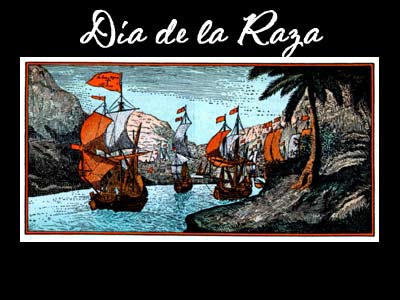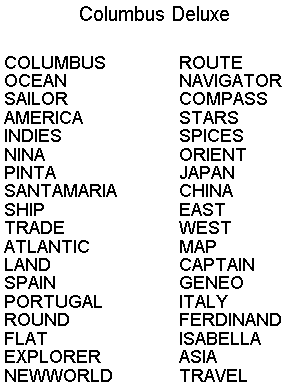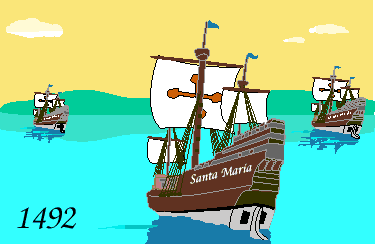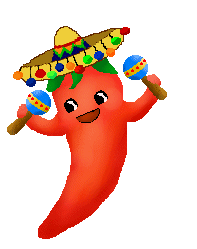
Dia
de la Raza |
What
is El Dia de la Raza?
October 12 (or the nearest Monday to it) is traditionally celebrated throughout
the Americas as the day Christopher Columbus arrived in 1492.
In English speaking countries, the day is celebrated as Columbus Day or
Native American Day. In Spanish speaking countries and communities, is is known
as Día de la Raza, the Day of the Race.
Día de la Raza is the celebration of the Hispanic heritage of Latin America
and brings into it all the ethnic and cultural influences making it distinctive.
It is celebrated on October 12 in Argentina, Chile, Costa Rica, Ecuador,
Honduras, Mexico, Uruguay and Venezuela.
|
Objectives:
* Students will recognize how Columbus' discoveries
effected the Native Americans.
* After reading Christopher Columbus, students will be
able to write a story about Columbus' first step on American ground from the
Native American point of view.
* Given the reader's theater on Christopher Columbus,
students will be able to place the events of Christopher Columbus' life and
voyage in order on a time line.
* Given the reader's theater, students will recognize
the characteristics of Columbus by completing a character sketch of him.
* Students will be able to write a letter with correct
grammar, punctuation and spelling.
Time Required:
1 week
Vocabulary:

Materials:
Christopher Columbus (book)
Background
Information
Reader's
Theater Play
* stamps
* reader's theater * envelopes
* poster paper
* paper
* map of the world
* markers
* pencil
* white and brown art paper
* water colors
* paint brushes
* glue
Procedures:
To find out what the students already know about Columbus Day, group the
children into four groups. Group them according to their birthdays: group one:
birthdays in January, February, and March; group two: April, May, and June;
group three, next three months; group four, last three months of the year. Have
the following questions on large sheets of poster paper:
* What did Columbus find when he reached his
destination?
* What happened to Columbus before he reached land?
* What do you think the Native Americans thought when
they saw Columbus and his men?
* What happened to the Native Americans after the
arrival of Columbus?
Assign each group a station and a certain color of
marker. After 3 minutes at the first station have the groups move to the next
station. Explain to them that they need to add to the list, but they can't write
anything that is already on the list.
Rotate the groups, so that each group has
a chance to contribute to each station. Have one person from each group be the
spokesman to tell the class the five most important things on their list.
Make
copies for every student in the classroom. Assign the main parts to
individual people and allow time for those people to read over their parts.
Remind the students that the whole class joins in on the parts that says
"All." This will develop the concept of Christopher Columbus, his life
and his voyage.
Explain to the children that Columbus was originally an Italian, but he got the
money from Spain so he claimed America for Spain. Explain that Columbus went on
four voyages and he thought that he never did find anything special. When he
died many people disliked his beliefs and he was ridiculed. He also thought of
himself as a failure because he never could find the Indies. Show on a map
Columbus' voyage.
At the conclusion of the reader's theater, have the students complete a
character sketch of Columbus. Include his origin, his characteristic of
endurance, his characteristic of pride and not letting others tell him he was
wrong, his great sailing abilities, etc.
What is a Character Sketch?
A character sketch highlights several
important characteristics or personality traits of a person -- a real person, a
person in literature, or an imagined person. A good character sketch provides
support detail for each identified trait.
Have
the students create a time line of when Columbus was born, until he died.
Include important dates in Columbus' life like the following: the day he set
sail for his first voyage, the day he landed, the day he returned to Spain,
dates of other voyages, etc.
Read
the book, Christopher Columbus by Jan Gleiter and Kathleen
Thompson. Read
up to page twenty-six and stop. Ask the students to write a story as if they
were the Native Americans on the island, watching the sailors come in on huge
boats and wearing fancy clothing. Have students share stories if desired.
Discuss with the students how the Native Americans
would have felt to see strange men dressed in strange clothing pull up in a huge
boat and kiss the ground and say funny things. It was probably quite a shock.
Discuss how the Native Americans were very generous with their belongings. Tell
the students that the name of the Native Americans that met Columbus were Tainos.
Tell the students that Columbus forced some Indians onto their boat, and later
ransacked their villages, made them into slaves and took many back to Spain.
From that time on, life for the Native Americans was difficult. They were
homeless in their own land. Explain what "to discover" actually means.
Explain that Columbus wasn't the first to discover America, the Native Americans
were. Also explain that today the Native Americans that once owned the entire
continent, now only have small reservations that they call home. Add to the
timeline when Native Americans first came to America.
Have the
students write letters to different organizations for information about
Christopher Columbus. Explain to the students what a good letter needs to
consist of. For example, the first paragraph should explain what the students
are studying in class. The second paragraph should be the questions that they
want answered. The third paragraph should show appreciation. Explain to the
children also where to indent, where commas should go in a letter and
appropriate words to use such as "Dear sir or madam," and
"sincerely." Send the letters to the following organizations and have
the student's questions be directed toward what happened to the Native Americans
because of Columbus and what happened to them after Columbus came.
Columbus: Countdown 1992
166-25 Powells Cove Boulevard
Beechhurst, New York 11357
Discovery Five Hundred
PO Box 1492
Columbus, New Jersey 08022
American Geographical Society Collection
Golda Meir Library
University of Wisconsin-Milwaukee
PO Box 604
Milwaukee, Wisconsin 53201
Christopher Columbus
Quincentenary Jubilee Commission
1801 F Street NW
Washington, DC 20006
Discuss any letters that the students might have received. Discuss that even
though Columbus' arrival was a great discovery for the people of Europe, it
proved to be unfortunate for the Native Americans. Then ask the students a final
question: "What do you know about Columbus' voyage and also how the voyage
affected the Native Americas?
Evaluation:
* Stories from the Native American perspective will be
assessed.
* Character sketches will be assessed by including three
characteristics required for passing.
* Observations during reader's theater.
* Letters will be assessed making sure the editing is
correct: grammar, spelling, punctuation.
* Time lines of Columbus' life and voyage will be
assessed with students meeting 80% accuracy.
* The students understanding of how Columbus changed the
Native American way of life will be assessed with a discussion.
Extension Activities:
Give
the students two pieces of white art paper. On one piece have them use water
colors to create a sunset. On the other use water colors to create the ocean.
Tear the ocean page into strips. Place the strips on the page with the sunset
creating the image of waves on the ocean. Have the students make a boat to place
in their pictures to represent Columbus' voyage.
Christopher
Columbus Scavenger Hunt
Home Learning:
Create a timeline at this website.
- Enter
"The Life and Times of Christopher Columbus" as the Title.
- Enter
your own name in the field By.
- Select
"Date" from the drop-down menu for Unit of Measure.
- Click
on "Next Entry" in the upper right-hand corner of the screen to
begin creating your timeline.
Instruct
students to build a timeline made up of at least five key dates or events
collected during their cyber scavenger hunt. To get students started, you might
model how to create a timeline entry using the LCD projector. Remind students to
print out their timeline when they are finished working. Monitor students
carefully to answer any questions they have while working and keep them on task.

Home |